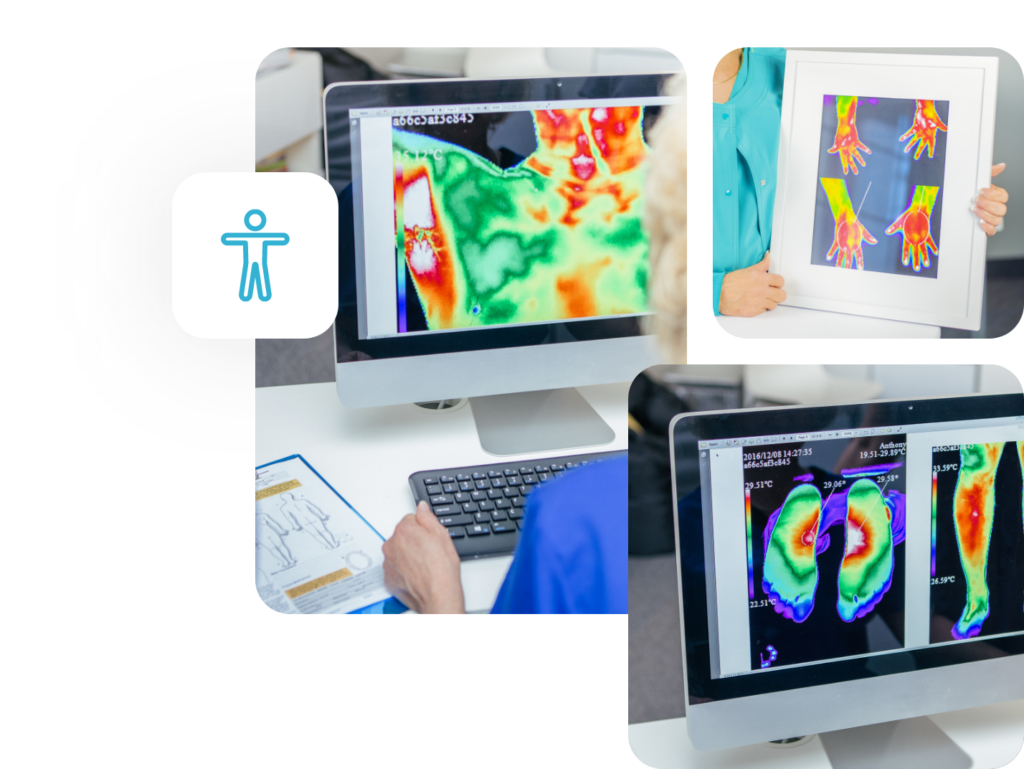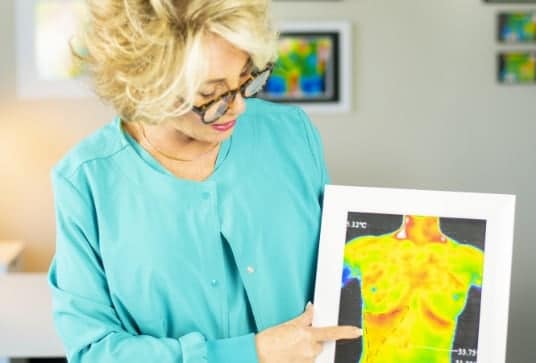
Services
Full & Half Body Thermography
Thermography assesses blood flow patterns, inflammation and function using advanced and highly sensitive infrared imaging equipment. It is a non-invasive, non-contact system of recording body temperature by measuring infrared radiation emitted by the body surface. It is a passive, pain free, fast, low cost and sensitive method.

Overview Breakdown
Full Body Thermography
Full Body Thermography identifies areas of abnormal heat patterns throughout your body, from the top of your head to the bottom of your feet. Certain heat patterns may suggest a diverse array of conditions, including chronic inflammation, infection, diseases, or other potential health concerns. It’s non-invasive, painless and is beneficial for individuals seeking a whole-body health assessment without exposure to ionizing radiation.

We follow a step-by-step process to ensure you receive the best care and results for your scans:
01
Intake Forms and Symptom Survey
Upon arrival, you will fill out intake forms and a symptom survey. This includes details about your past surgeries, current symptoms, any areas of discomfort, and so on.
02
Consultation
After completing the forms, we sit down with you to discuss your symptom survey in depth. This consultation is a crucial part of the process as it allows us to thoroughly explore your medical history, understand your current symptoms, and answer any questions you may have about thermography. For many clients, their knowledge of thermography may be limited or they may have learned about it through social media platforms like TikTok, so we take the time to educate you about the process and its benefits.
03
Initial Scan Process
As Certified Clinical Thermographers (CCT), our role is akin to that of an x-ray technician in conventional medicine. We perform the thermal imaging scans, then send the images to Dr. Gregory Melvin, our Board Certified Clinical Thermologist. He reads and analyzes the images and then creates a detailed report of findings.
04
Post-Scan Plan
Once Dr. Melvin has interpreted the results, we discuss the findings with you and address any acute issues. From there, we come up with a plan for future scans and interventions based on these findings.
05
Follow-Up Scans (Recall)
After the initial scan, we typically recommend follow-up scans to track the client’s progress and changes in their thermal patterns. These usually occur three months, six months, and 12 months after the initial scan. The goal of these follow-up scans is to compare the results with the baseline obtained during the initial visit, and ensure everything is moving in the right direction. Finally, we advise yearly scans for ongoing monitoring and proactive health care.
Full & Half Body
Thermography Statistics

Select The Scan That’s Right For You
Full-Body Scan
Our full body scan is our most popular scan and our most comprehensive study; the most complete medical scan available.
- Varicosity
- Phlebitis
- Plantar fasciitis
- Circulatory and nerve damage related issues
- Neuropathy
- Pancreatic issues
- Pre-diabetic developments
- Everything included in the Half-Body Scan
- Everything included in the Breast Screening Scan
- … and so much more
Half-Body Scan
Top of the head to the pubic bone. Includes 19 images.
- Full cranial
- Deep-rooted periodontal issues (often missed on dental x-rays)
- Comprehensive thyroid
- Carotid artery
- Coronary issues
- Complete breast scan (note breast scan details)
- Lymphatic congestion and lymph node activity above the clavicle and under the arms
- Full spine (upper and lower back)
- Major organs: stomach, diaphragm, gallbladder, liver, large and small intestines, kidneys, ascending and descending colon, ovaries, uterus, bladder, etc.
- Intestinal inflammation
- … and more
Full & Half Body
Thermography FAQs
Thermography measures temperature variations using sophisticated and sensitive high tech equipment. These changes in the body’s temperature can indicate disease processes which can be used to indicate abnormalities in wellness long before the body’s own sensory organs can identify them. Thermography can be used to diagnose breast cancer, thyroid disease, inflammation, heart disease, and many other diseases.
Thermography assesses blood flow patterns, inflammation, and function using very sensitive equipment. It is a non-invasive, non-contact system of recording body temperature by measuring infrared radiation emitted by the body surface. It is a passive, pain-free, fast, low cost and sensitive method.
Full body thermography is a comprehensive assessment of your body’s heat patterns, covering everything from the top of your head to the bottom of your feet. It identifies areas of abnormal heat patterns, which can indicate diverse conditions like inflammation, infection, or other potential health concerns. Thermography assesses blood flow patterns, inflammation, and function using advanced and highly sensitive equipment, which measures infrared radiation emitted by the body surface.
A thermogram has some advantages in detecting breast abnormalities over a mammogram and an ultrasound, including the ability to detect physiologic changes in cancer while it’s still in the cellular phase, sometimes years before it is detectable mammographically or through an ultrasound.
Thermography can also detect lymphatic congestion and hormonal imbalances, as well as monitor dietary changes. It can assess breast cancer risk, which is also something mammography and ultrasound technology cannot do.
